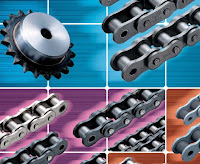Chain Drives Design (Part 1)

Chain drives are used to transmit rotational motion and torque from one shaft to another, smoothly, quietly and inexpensively. Chain drives provide the flexibility of a belt drive with the positive engagement like a gear drive. Therefore, the chain drives are suitable for applications with large distances between shafts, slow speed and high torque. Usually, chain is an economical part of power transmission machines for low speeds and large loads. However, it is also possible to use chain in high-speed conditions like automobile engine camshaft drives. This is accomplished by devising a method of operation and lubrication. Compare to other forms of power transmission, chain drives have the following advantages: Chain drives have flexible shaft center distance, whereas gear drives are restricted. The greater the shaft center distance, the more practical the use of chain and belt, rather than gears. Chain can accommodate long shaft-center distances (less than 4 m), and is more...





